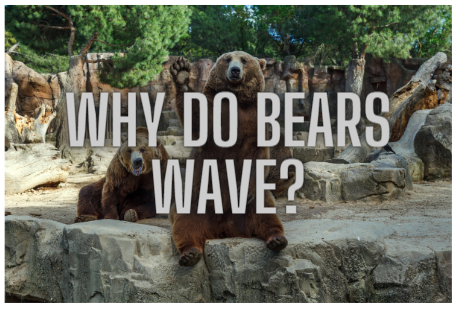One of the most endearing and captivating behaviors exhibited by bears is their occasional waving gesture. While it may seem like a friendly human-like wave, the reasons behind this behavior are quite intriguing. In this article, we will delve into the world of bear waving, exploring the possible explanations and theories surrounding this fascinating phenomenon. By understanding the factors that contribute to this behavior, we can gain a deeper appreciation for the complex social and communicative lives of bears.
The Wave: Observations and Context
Bear waving refers to the act of bears raising their front paws in a seemingly waving motion. This behavior has been observed in various bear species, including brown bears, black bears, and polar bears. It is typically characterized by the bear standing on its hind legs and lifting one or both front paws, often in the presence of other bears, humans, or perceived threats. The waving gesture is often accompanied by other body language cues, such as huffing, jaw popping, or swaying back and forth.
Possible Explanations and Theories
Communication and Social Significance: One theory suggests that bear waving is a form of communication within bear social groups. It may serve as a non-aggressive signal, indicating submissiveness or a desire to avoid conflict. By displaying their paws, bears may be signaling that they are not a threat and are willing to peacefully coexist.
Visual Display and Dominance: Another theory proposes that bear waving is a visual display of size and strength. When a bear stands on its hind legs and waves its paws, it appears larger and more imposing, potentially asserting dominance over rivals or deterring potential threats.
Curiosity and Playfulness: Some researchers suggest that bear waving could be driven by curiosity and playfulness. Bears are known for their intelligence and inquisitive nature, and waving might be a way for them to explore and interact with their surroundings, including humans.
Imitation and Learned Behavior: In certain cases, bears may have learned to wave by observing human behavior. In areas where bears have frequent encounters with humans, they might have picked up the waving gesture as a means of communication or as a way to solicit food rewards.
Defensive Strategy: Bear waving has also been observed in situations where bears feel threatened or perceive a potential danger. By raising their paws and displaying their size, bears may be attempting to intimidate or warn off potential threats, including other bears or predators.
Cultural and Individual Variations
It is important to note that not all bears exhibit waving behavior, and there can be variations among different populations or individuals. Some bear species, such as grizzly bears, are more commonly associated with waving, while others, like polar bears, exhibit this behavior less frequently. Environmental factors, such as the presence of humans or specific social dynamics within a bear population, can influence the likelihood of waving behavior.
Conservation and Ethical Considerations
While bear waving is an intriguing behavior to observe, it is essential to remember that bears are wild animals and should be treated with respect and caution. Interactions with bears should be approached with appropriate measures to ensure both human and bear safety. It is crucial to follow guidelines and regulations established by wildlife management authorities to minimize disturbances and avoid habituating bears to human presence.
Final Thoughts
Bear waving is a captivating behavior that offers insights into the complex social dynamics and communication strategies of bears. While the exact reasons behind this behavior may vary, it is likely a combination of factors such as communication, dominance display, curiosity, and defense. By studying and appreciating bear waving, we can deepen our understanding of these remarkable creatures and the intricate ways they navigate their environments. However, it is vital to prioritize responsible and ethical interactions with bears to ensure their continued well-being and conservation in the wild.

